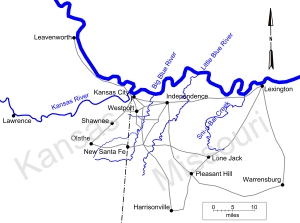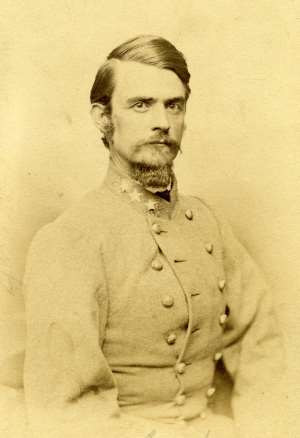Search:
Powered by
Website Baker
Battle of the Little Blue River, October 21, 1864
|
Regional map of west central Missouri (click for larger image) |
Although Major General Sterling Price was a bit under the weather on October 20, his commanders were under orders to continue pressing west. That meant getting across the Little Blue River, reaching Independence, and then continuing on to New Santa Fe. A trip of less than 30 miles or so was certainly feasible, assuming they could brush aside any opposition from the Federal defenders. It was important to keep moving so the Federal pursuit from the east couldn’t catch up. As you can imagine, the Confederates were a bit spread out, as only12,000 campers could be. On October 21, some units were on the move as early as 3:00 a.m.
|
John B. Clark, Jr. courtesy of the Wilson’s Creek National Battlefield, National Park Service |
The first order of business was to gain control of the bridge over the Little Blue River and secure the road into Independence. It was Major General John S. Marmaduke’s job to make this happen. From this point, Marmaduke sent his escort forward as a skirmish line. So about 7:00 a.m. Captain D. R. Stallard, Company D, Fifth Missouri Confederate Cavalry, led his men toward the bridge. Brigadier General John B. Clark, Jr. described the initial attack in his official report.
"[We came] in contact with the enemy [on] the 21st at the crossing of Little Blue River, in Jackson County. My brigade being in advance, Captain Stallard's escort (Marmaduke's advance guard), came upon the enemy's pickets one mile from the bridge on Little Blue on the Lexington and Independence road. Stallard soon drove them across the bridge, which they burned to prevent a rapid pursuit."
Opposing the Confederate army was Colonel Thomas Moonlight, commanding the Eleventh Kansas Cavalry Regiment. At first Major General Blunt was going to leave Moonlight with only a skeleton force, but Moonlight convinced him to leave most of Moonlight’s regiment on the west side of the Little Blue River. Both Blunt and Moonlight thought the Little Blue River was the best place to stop the enemy’s advance. This was in direct opposition to their commander’s desire to defend at the Big Blue River. While Blunt went to consult with Curtis, he ordered Moonlight to fall back to Independence should the Confederates move on their position. Blunt made it clear to Moonlight not to engage the enemy. Moonlight explained why he did not follow his orders.
"On the morning of the 21st the enemy came down on us, flushed with what they considered a victory at Lexington and eager for the fray. The bridge was burned and the advance, for a short time, checked … I held my ground for about an hour, but my force was too small to guard the flanks, and I was reluctantly compelled to fall back, fighting in violation of orders.
"As I had already violated my instructions, I thought I might do a little more. In fact, I was determined to make Little Blue a battlefield, orders or no orders, for every day, every mile, that we delayed the advance of the enemy kept him that much longer out of Kansas, truly giving the militia time to make the scene of action, and the Missouri Troops, under Pleasanton [and] following Price's army, an opportunity to close on him, and the sequel proved the correctness of my position.
"Having marched on [the] open part of the country, with only fences to impede my movements, the command was splendidly dismounted, the horses were left in the rear and the enemy were charged back in return. For over a mile did we drive them, having their dead & wounded strewing the ground. Then we held them until re-enforcement under Genl. Blunt came up to my assistance, by which time there was scarcely a round of ammunition in my command. We supplied its place, however, by shouting defiance at the enemy. About 3 P.M. the retreat was ordered to Independence; and on the route I overtook the ammunition train, supplied each man with 80 rounds, and was again ready for any emergency As the division reached Independence the sun was setting, and although we endeavored to find a good position for defense, was compelled to continue the retreat. My brigade was here again given the point of honor and danger and we fought the enemy in the streets of Independence until dark, allowing the command time to take up positions on [the] Big Blue. It was near midnight ere we reached a field of com and threw ourselves to the hard ground to sleep- Wagons & camp equipage were not (and very properly, too) allowed to any brigade."
Moonlight’s decision to fight at the Little Blue River turned out well for the Federals. Blunt was able to convince Curtis to fight a delaying action at the Little Blue River, giving them more time to improve their defense line on the Big Blue River. After Blunt returned to the Little Blue River late in the morning, the Federals kept Price’s army at bay for the rest of the day. As darkness came, the Federals fell back through Independence to the Big Blue River.

